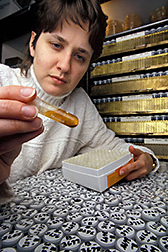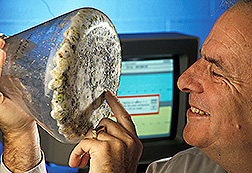Fungi-Fragment Pesticides
|
|
Bits of fungi that live in soil could be the cornerstones of new environmentally friendly insecticides.
ARS microbiologist Donald T. Wicklow and entomologist Patrick F. Dowd, with University of Iowa chemist James B. Gloer, found in fungal bits—sclerotia—at least 85 natural compounds that are toxic to insects. Some could end up as new biological insecticides.
Sclerotia look like tiny specks of black pepper on plants or insects attacked by these fungi.
They help fungi survive bad weather, such as drought or freezing temperatures, and even help the fungi cope with the absence of a suitable plant or insect host.
Since many insects eat fungi, Wicklow believes that sclerotia may have evolved chemical defenses to protect them from insects.
Wicklow, Dowd, and Gloer have screened extracts from about 200 fungi for new insecticidal compounds. They have isolated over 125 that tested positive as potential insecticides and selected 85 for testing. About 60 are new to science.
"Several even belong to new families of chemicals previously unknown," says Gloer, whose research group at Iowa City identified the compounds.
"Some of the compounds from sclerotia are comparable to malathion in their toxicity to insects," says Dowd, an ARS entomologist.
|
|
Malathion is a commercial insecticide that acts as a stomach poison to many insects.
He fed the sclerotia compounds to crop-damaging insects like corn earworm caterpillars and sap beetles in studies at the National Center for Agricultural Utilization Research (NCAUR) in Peoria, where he and Wicklow are based.
A few of the compounds look promising as ingredients for toxic baits such as those now used to control cockroaches and ants. Sex and food scents attract insect pests to the baits.
One of the newer compounds is Shearinine B. isolated from the fungus Eupenicillium shearii. In laboratory tests, Dowd applied Shearinine B to plant leaves and placed fall armyworms on them. Eighty percent of the pests died within 24 hours.
According to Wicklow, fungal sclerotia of certain plant pathogens have survived burial in agricultural fields for up to 10 years. As sclerotia germinate, they form spores that are spread from soil to plants by wind, splattering raindrops, or insects.
The fungal bits might be mass-produced by slightly modifying processes already used in the fermentation industry and in corn wet milling.
Wicklow began searching in 1986 among the NCAUR's culture collection for fungi that produce sclerotia. The collection of fungi, yeasts, and molds is one of the world's largest.
ARS has received several patents on the fungal compounds. The studies were also supported by the Biotechnology Research and Development Corporation in Peoria and the National Science Foundation. — By Linda Cooke, ARS.
Donald T. Wicklow and Patrick F. Dowd are in the USDA-ARS Mycotoxin Research Unit, National Center for Agricultural Utilization Research, 1815 N. University, Peoria, IL 61604; phone (309) 681-6243 (Wicklow), (309) 681-6242 (Dowd), fax (309) 681-6689.
"Fungi-Fragment Pesticides" was published in the January 1995 issue of Agricultural Research magazine.








